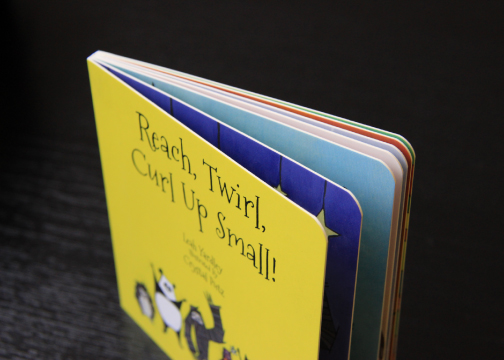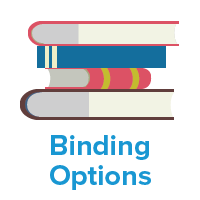In the publishing world, picking a binding isn’t just about practicality; it complements the content. Each style has unique features shaping the book’s construction, visual appeal, and functionality. Let’s explore binding styles and their best genres, uncovering the link between form and content.
1. Perfect Bound

Perfect bound books are softcover and are bounded using glue and is one of the most common binding method for paperbacks.
Best recommended Genre: Novels, biographies, Non-fiction
Why: These books can be effortlessly arranged for stacking and storage convenience, these items are crafted in a manner that allows the printing of the book or magazine title directly along the spine, adding a practical and aesthetic dimension to their presentation on shelves or in storage spaces.
2. Saddle Stitch

Saddle stitch books have sheets of paper that are folded and assembled with one inside the other, then secured along the fold line using wire staples. Saddle stitch offers lay-flat capabilities.
Best Recommended Genres: Comic Books and Children’s Books
Why: Saddle Stitching is the preferred binding for low-page-count books, offering a simple yet professional appearance across various dimensions—from pocket-sized to oversized. This method minimizes weight and bulk, cutting down mailing and shipping costs, and is adaptable for short, medium, or long production runs.
3. Thread Stitch

Thread stitching is a process where sections of pages are physically sewn together. This technique allows the book to lay flat, enhancing the reading experience. Thread stitching is often chosen for its durability and its ability to showcase visual elements seamlessly.
Best Recommended Genres: Notebooks and Journals
Why: Similar to saddle stitch, thread stitching is best used for low page count book, but adds more longevity to the book. Better used for extended and repeated uses of opening and closing the book and more durability compared to saddle stitch – but has more of a classy look.
4. Hardcover Smyth Sewn

Hardcover Smyth sewn books feature a hardcover and sewn binding. Sections of pages are sewn together before being attached to the hardcover, providing durability and a lay-flat design. This binding style is known for its sturdiness and professional appearance.
Best Recommended Genres: Memoirs, Textbooks, Coffee Table Books, Cookbooks, Photobook Books
Why: The biggest advantage to using hardcover smyth sewn is the lay-flat binding. Cookbooks stay open for easy recipe following, especially useful during messy cooking. Artbooks benefit with seamless visuals, ensuring details and panoramas are fully visible without interruptions. Similar with memoirs, textbooks, coffee table books and more. Anything that requires longevity, seamless visuals, or to be open on one page for a long period of time should be using smyth sewn binding.
5. Hardcover Gluebound

Hardcover gluebound books have a sturdy hardcover, and their pages are securely bound using glue. This combination adds a touch of sophistication, making it an appealing choice for visually striking editions.
Best Recommended Genres: Fiction Anthologies and Reference Books
Why: Hardcover glue bound books suit Fiction Anthologies and Reference Books. Despite not laying flat, their durability and structure endure repeated use, making them reliable for literary exploration and reference.
6. Flexibound Book

Flexibound books strike a balance between paperback flexibility and hardcover durability. They typically feature a soft but sturdy cover, offering a versatile and comfortable reading experience.
Best Recommended Genres: Travel Guides and Journals
Why: Similar to hardcover smyth sewn, the flexibound style is a layflat binding, but is also lightweight and pliable. This makes the book more practical and portable that many journal lovers like, appealing to readers who value both durability and the comfort of not being too heavy.
7. Wire-O

Wire-O binding utilizes a metal wire to secure the pages, allowing the book to lay flat and also fold to the back. This method is practical for easy accessibility and durability.
Best Recommended Genres: Workbooks, Planners, Cookbook and Calendars
Why: Workbooks, planners, cookbooks and calendars benefit from the lay-flat capability, allowing users to jot down important dates, notes or to keep looking back without the hassle of wrestling with pages snapping back at them.
8. Coil Bound Book

Coil bound books are bound together using a spiral plastic coil. This cost-effective and practical binding style allows for easy flipping, layflat capabilities and flexibility in turning the page.
Best Recommended Genres: Cookbooks, Manuals and Workbooks
Why: Similar to wire-o, coil bound books have an easy to flip page, which finds their niche in cookbooks, manuals and workbooks. This binding style offers practicality for educational materials, allowing users to reference and study with ease because of its lay flat capabilities, making it a staple in classrooms, workshops and in the kitchen.
9. Board Books

Board books are specifically designed for durability, featuring thick pages made of board material. The board construction ensures that these books can withstand frequent handling, making them ideal for young readers.
Best Recommended Genres: Children’s Books
Why: Board books are the sturdy companions of young readers. With pages made of thick board, these books can withstand the wear and tear that comes with curious little hands. Toddlers can tear sheets of paper easily and can be more prone to injury, but the durability of board books makes them a natural choice for children’s literature. Board books provide a real full spread that is printed on one single sheet ensuring that no artwork is shifted on the spine during assembly.
In conclusion, the choice of book binding is an integral part of the storytelling process. Whether it’s the robustness of hardcover Smyth sewn for textbooks or the playful flexibility of coil binding for manuals, each style contributes to the overall reading experience. So, the next time you pick up a book, take a moment to appreciate not just the words within but also the craftsmanship that went into binding them together.







